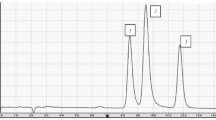Summary
Thymoxamine is rapidly and completely absorbed in man. Rapid biotransformation is observed after intravenous a n d oral administration of 40 mg l14C-thymoxamine HC1. No unchanged compound i s found in the body. More than 90% of plasma and urine radioactivity could be ascribed to six metabolites : the desacetyl compound (metabolite I), the monodemethylated metabolite I (metabolite II), the sulfate conjugates of I and II (metabolites III and IV) and the glucuronides of I and II (metabolites V and VI).
The unconjugated metabolites are observed in plasma only after intravenous administration. Similar patterns for polar metabolites are found in plasma and urine for both routes of administration. The sulfate fraction amounts to about 50–60% and the glucuronide fraction to about 30–40% of t h e radioactivity, the conjugates of metabolite I being more abundant than those of metabolite II.
The elimination of the metabolites is rapid, the half-life of radioactivity elimination being 1.5 h during the first 12 hours and 12 h thereafter. 80% of the radioactivity dose is recovered in the urine within 4 hours. Recovery after four days amounts to 99.8% (i.v.) and 97.7% (oral).
The results are discussed with regard to the application of the drug in man, taking into account that not only the unconjugated metabolites but also the sulfate conjugates are pharmacologically active.
Similar content being viewed by others
References
Vollmer K.-O., Liedtke B., Poisson A., von Hodenberg A. and Steinbrecher W. (1985): Metabolism of thymoxamine-I: Studies with14C-thymoxamine in rats. Europ. J. Drug Metab. Pharmacokin.,10, 61–69.
Vollmer K.-O. and von Hodenberg A. (1985): Metabolism of thymoxamine-III: Structures of metabolites and species differences. Europ. J. Drug Metab. Pharmacokin.,10, No 2.
Vollmer K.-O. und Herrmann M. (1972): Phosphorsauremonoester von 5-(2-Dimethylaminoathoxy)-carvacrol, Verfahren zu seiner Herstellung und diesen enthaltende Arzneimittel. German Patent.22, 38260.
Vollmer K.-O. und Poisson A. (1976): Zum Metabolismus von DL-trans-2-Dimethylamino-1 -phenyl-cyclohex-3-entrans-1-carbonsäureäthylester-hydrochlorid (Tilidin-HCl — 2. Mitteilung: Untersuchungen mit der radioaktiv markierten Substanz an Ratten und Hunden. Arzneim.-Forsch. (Drug Res.),26, 1827–1836.
Wasilewski A. (1971): Klinisch-pharmakologischer Nachweis der Wirkung von Essigsäure-[4-(2-dimethylaminoätoxy)-5-isopropyl-2-methyl-phenyl]-ester-HCl (Moxisylyt). Arzneim.-Forsch. (Drug Res.),21, 1183–1189.
Rech H. (1971): Grenzen der chirurgischen und Möglichkeiten der konservativen Behandlung peripherer arterieller Durchblutungsstörungen. Med. Welt,22, 1284–1288.
Mutschler E. (1981): Arzneimittelwirkungen — 4. Auflage, S. 258, Wissenschaftliche Verlagsgesellschaft mbH Stuttgart.
Author information
Authors and Affiliations
Rights and permissions
About this article
Cite this article
Vollmer, K.O., Poisson, A. Metabolism of thymoxamine II. Studies with14C-Thymoxamine in man. European Journal of Drug Metabolism and Pharmacokinetics 10, 71–76 (1985). https://doi.org/10.1007/BF03189699
Received:
Issue Date:
DOI: https://doi.org/10.1007/BF03189699




